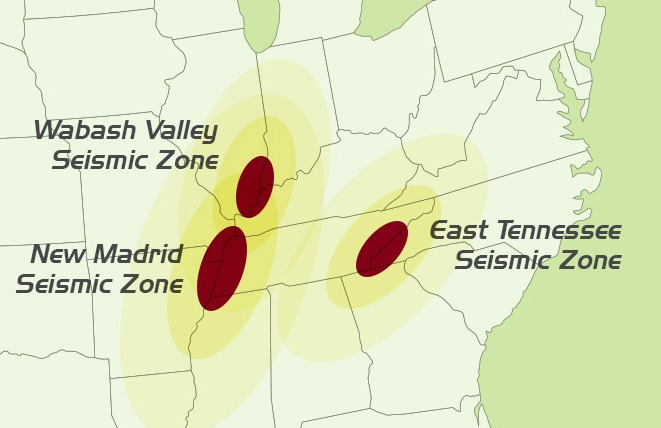
Earthquakes are the sudden, rapid shaking of the earth, caused by the breaking and shifting of subterranean rock as it releases strain that has accumulated over a long time. Initial mild shaking may strengthen and become extremely violent within seconds. Additional earthquakes, called aftershocks, may follow the initial earthquake. Most are smaller than the initial earthquake but larger magnitude aftershocks also occur.
Earthquakes can happen at any time of the year and occur without warning, although they usually last less than one minute. Aftershocks following the initial earthquake may occur for hours, days, or even months. All 50 states and 5 U.S. territories are at some risk for earthquakes.
The risk is higher in identified seismic zones including:
- the San Andreas Fault in California,
- the Cascadia Subduction Zone in western Oregon and Washington and Alaska,
- the New Madrid Fault Zone spanning areas in Missouri, Arkansas, Tennessee, and Kentucky
- and areas on the east coast including the mid-Atlantic, coastal South Carolina, and New England.
In California and the western U.S. States, earthquake faults can be hundreds of miles long and be visible on the surface of the earth. In the central U.S. however, faults are buried deep underground and are generally categorized as “seismic zones”, or areas where many smaller faults are clustered together to produce seismic activity. While some zones, such as the New Madrid Seismic Zone, may be more widely known, others such as the East Tennessee and Central Virginia Seismic Zones can also produce damaging earthquakes at any time.
 Most recent Indiana Earthquakes:
Most recent Indiana Earthquakes:
- 2015 MAY 28 - HAUBSTADT (M 2.3)
- 2012 MAY 10 - BICKNELL (M 3.1)
- 2012 MAY 10 - BICKNELL (M 2.7)
- 2012 APR 11 - WASHINGTON (M 2.2)
- 2012 JAN 26 - EMMA (M 3.0)
- 2010 DEC 30 - GREENTOWN (M 3.8)
- 2009 DEC 30 - POSEYVILLE (M 1.1)
- 2009 DEC 24 - PRINCETON (M 1.6)
- 2004 SEPT 12 - MORRISTOWN (M 3.8)
- 2003 JAN 03 - MOUNT VERNON (M 2.9)
- 2002 JUL 18 - MOUNT VERNON (M 4.6)
- 2000 DEC 07 - EVANSVILLE (M 3.9)
- 2000 AUG 26 - EVANSVILLE (M 2.9)
- 2000 APR 13 - GREENCASTLE (M 3.6)
- 2000 MAR 06 - DARNSTADT (M 2.7)
Before an Earthquake
Movement of the ground seldom is the actual cause of death or injury. Most casualties result from partial building collapses, falling objects, and debris, like toppling chimneys, falling bricks, ceiling plaster, and light fixtures. Many of these conditions can be prevented by taking a few steps now to prepare.
- Before an earthquake occurs, secure items that could fall or move and cause injuries or damage (e.g., bookshelves, mirrors, light fixtures, televisions, computers, hot water heaters. Move beds away from windows and secure any hanging items over beds, couches, cribs, or other places people sit or lie.
- Locate master switches and shutoff valves for all utilities and know how to turn them off.
- Plan and practice how to Drop to the ground, Cover your head and neck with your arms, and if a safer place is nearby that you can get to without exposing yourself to flying debris, crawl to it and Hold On to maintain cover.
- Prepare an emergency kit that includes a portable battery-operated radio, flashlight, extra batteries, an adjustable wrench for turning off gas and water, a first aid kit, and enough food and water for 72 hours
- Plan how you will communicate with family members, including multiple methods by making a family emergency communication plan.

In Case of an Earthquake
- DROP where you are, onto your hands and knees. This position protects you from being knocked down and also allows you to stay low and crawl to a shelter if nearby.
- COVER your head and neck with one arm and hand. If a sturdy table or desk is nearby, crawl underneath it for shelter. If no shelter is nearby, crawl next to an interior wall (away from windows). Stay on your knees; bend over to protect vital organs.
- HOLD ON until the shaking stops. Under shelter: hold on to it with one hand; be ready to move with your shelter if it shifts. No shelter: hold on to your head and neck with both arms and hands.
- Wherever you are, stay there! Most injuries occur when people try to enter or exit buildings.
- If indoors, take cover under heavy furniture or against a wall. Stay away from glass, bookshelves, or wall hangings.
- If you are in bed: Stay there and cover your head and neck with a pillow. At night, hazards and debris are difficult to see and avoid; attempts to move in the dark result in more injuries than remaining in bed.
- If outside: Move into the open. Stay away from buildings and utility wires.
- If you're driving: Stop quickly (but safely)and stay in the vehicle.
After an Earthquake
- Examine utility lines, chimneys, and appliances for damage.
- If you see electrical damage, switch off the electrical power at the main panel.
- If you see damaged water pipes, cut off the water supply at the main valve.
- If you smell natural gas, shut off the main valve and open the windows. Leave the building and call local officials. Don't use open flames or turn on electrical devices until instructed.
- Listen to the radio for official updates or instructions.
- use the phone only to report a life-threatening emergency.
Don't Wait! Prepare for Earthquakes
- Inspect ceilings and foundations for cracks or signs of weakness. Have them repaired.
- Store chemicals and breakable items in low, closed cabinets with latches. Place heavy objects on lower shelves.
- Bolt or strap cupboards, shelves, and bookcases securely to walls. Brace overhead light fixtures.
- Hang heavy items (such as pictures) securely and away from where people sit.
- Secure water heaters by strapping them to wall studs and bolting them to the floor.
- Install blots to connect your home to its foundation.
- Strap down televisions, computers, and other heavy objects that can shift during a quake.
Important Links
- The Great Central US Shake Out
- Central United States Earthquake Consortium
- Ready.gov - Earthquakes
- IDHS - Earthquake Preparedness
- PDF - FEMA - How To Prepare for an Earthquake
- American Red Cross - Earthquake Safety
- PDF - What to do during an Earthquake
- PDF - Central US Earthquake Guide
- Video - FEMA When The Earth Shakes
- IU - Indiana Earthquakes
- Earthquake Tracker
